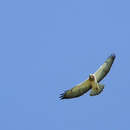More info for the terms:
shrubs,
tree,
tundraThe Swainson's hawk inhabits mostly semiopen to open areas in tundra,
valleys, plains, dry meadows, foothills, and level uplands at low to
middle elevations [
1,
31,
40].
Nesting habitat - The Swainson's hawk nests almost exclusively in trees
[
37] and will nest in almost any tree species of suitable size (taller
than 10 feet [3 m] with a d.b.h. of 2 inches [5 cm] or more) [
6,
7].
Nests are constructed in isolated trees (dead or live), in trees in
wetlands and along drainages, or in windbreaks in fields and around
farmsteads [
6,
12,
31]. The Swainson's hawk builds nests from 4 to 100
feet (1.2-30.4 m) above the ground [
12,
14,
35]. They sometimes add to an
existing black-billed magpie (Pica pica) nest [
31]. The Swainson's hawk
occasionally nests in shrubs, on the crossbars of telephone poles, or on
the ground, low cliffs, rocky pinnacles, or cutbanks [
6,
12,
31].
In the Central Valley of California, the majority of Swainson's hawk
nests and territories are located in or near riparian systems. Nests
are found most often in cottonwoods and oaks [
33]. In Whitman County,
Washington, Swainson's hawk nests were constructed in black locust
(Robinia pseudoacacia), cherry (Prunus spp.) and hawthorn (Crataegus
spp.) trees [
5]. Of 48 Swainson's hawk nests on the Laramie Plains,
Wyoming, 43 were in narrowleaf cottonwood (Populus angustifolia),
peachleaf willow (Salix amygdaloides), or other willows. None of the
few buttes in the area were used for nesting [
15]. In the Centennial
Valley of Montana, Swainson's hawks nest extensively in willows [
32].
At 234 Swainson's hawk nest sites in North Dakota, eastern cottonwood
(Populus deltoides) was the most common tree species used (45%). Other
species included Chinese elm (Ulmus parvifolia), 22 percent; peachleaf
willow, 13 percent; boxelder (Acer negundo), 12 percent; and green ash
(Fraxinus pennsylvanica), 7 percent. American elm (U. americana) and
Russian olive (Elaeagnus angustifolia) accounted for the remaining 1
percent [
20]. In the Lower Sonoran Desert of New Mexico, the Swainson's
hawk often nests and roosts on large yucca plants [
30]. In the
southwestern United States, mesquite is commonly used [
6].
Foraging habitat - The Swainson's hawk generally forages in open
habitats with short vegetation containing small mammals, reptiles,
birds, and insects [
6,
40,
38]. During the nesting season the Swainson's
hawk usually forages within 1.9 miles (3 km) of the nest. The
Swainson's hawk has a home range of approximately 3.5 square miles (9 sq
km) [
40]. Although the Swainson's hawk does search for prey from
elevated perches, it relies much more on aerial foraging. Consequently,
it is not tied to habitats containing an abundance of perches, and often
occupy habitats with few or no perches except the nest tree [
23].
Winter habitat - The Swainson's hawk generally spends the winter south
of the United States [
1,
12,
31]; no information is available in the
English literature on its habitat in Central and South America.

